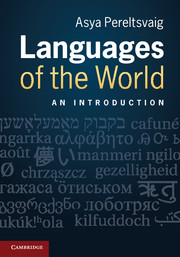Book contents
- Frontmatter
- Contents
- Figures
- Maps
- Tables
- Words, words, words…
- Acknowledgements
- Abbreviations used in the glosses
- 1 Introduction
- 2 Indo-European languages
- 3 Non-Indo-European languages of Europe and India
- 4 Languages of the Caucasus
- 5 Languages of Northern Africa, Middle East and Central Asia
- 6 Languages of sub-Saharan Africa
- 7 Languages of eastern Asia
- 8 Languages of the South Sea Islands
- 9 Aboriginal languages of Australia and Papua New Guinea
- 10 Native languages of the Americas
- 11 Macro families
- 12 Pidgins, creoles and other mixed languages
- Glossary
- References
- Index of languages
- Index of terms
11 - Macro families
- Frontmatter
- Contents
- Figures
- Maps
- Tables
- Words, words, words…
- Acknowledgements
- Abbreviations used in the glosses
- 1 Introduction
- 2 Indo-European languages
- 3 Non-Indo-European languages of Europe and India
- 4 Languages of the Caucasus
- 5 Languages of Northern Africa, Middle East and Central Asia
- 6 Languages of sub-Saharan Africa
- 7 Languages of eastern Asia
- 8 Languages of the South Sea Islands
- 9 Aboriginal languages of Australia and Papua New Guinea
- 10 Native languages of the Americas
- 11 Macro families
- 12 Pidgins, creoles and other mixed languages
- Glossary
- References
- Index of languages
- Index of terms
Summary
In the previous ten chapters we have examined a number of well-established language families, such as Indo-European, Semitic, Turkic, Austronesian and others. A question that may be asked at this point is whether any of these language families are related to each other inside even bigger groupings. Such groupings are alternatively referred to as clades, phyla (singular: phylum) or macro language families. Here, I will use the latter term.
The question of such macro families has occupied many an inquisitive mind and hypotheses are plentiful. Various rather far-fetched theories, such as Amerindian, Nostratic, Eurasiatic and Proto-World, have received much attention not only in professional academic circles but in the popular press as well and have been featured in Atlantic Monthly, Nature, Science, Scientific American, US News and World Report, The New York Times and in BBC and PBS television documentaries. While some proposed long-distance relationships and macro families are quite well proven and as a result widely accepted among historical linguists, others are more controversial, and yet others are so far fetched that they are not accepted by linguists other than those who originally proposed them.
- Type
- Chapter
- Information
- Languages of the WorldAn Introduction, pp. 205 - 229Publisher: Cambridge University PressPrint publication year: 2012



